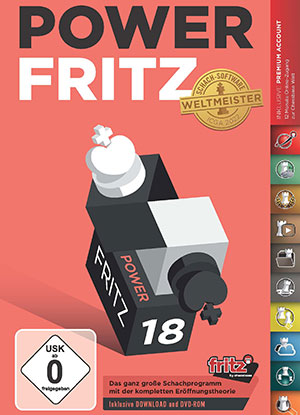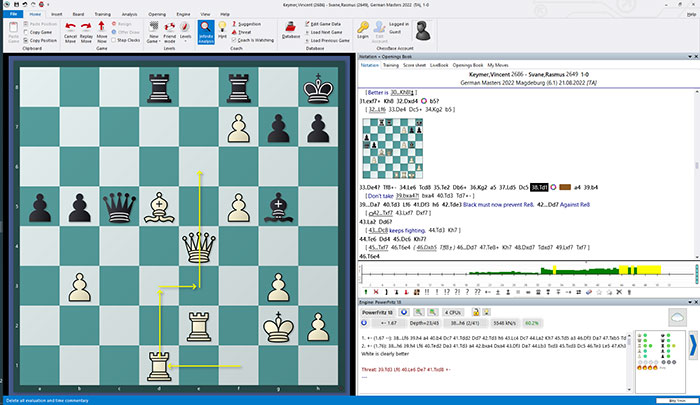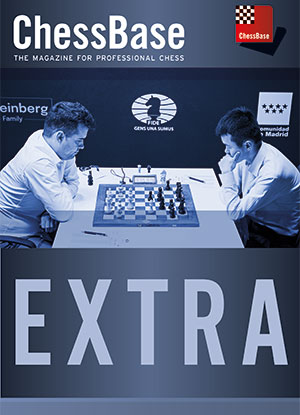CHESSBOOK REVIEWS

Latest book
reviews of 1 November 2022
Wilhelminalaan 33
7261 BP RUURLO
The Netherlands.
John
Elburg
Chess DVD's

Power Fritz 18
http://www.chessbase.com
E-Mail
info@chessbase.com
2022
Price Euro 79.90
Languages: English, German, French, Spanish, Italian
ISBN: 978-3-86681-860-6
EAN: 9783866818606
System: Windows 8.1 or higher
Published: Sep 2022
Delivery: Download, Postal Delivery
Level: Any
Minimum: PC Intel i3 or i5 or Ryzen 3, 4 GB RAM, Windows 8.1 (32- or
64-Bit), DirectX11, graphic card with 512 MB RAM, DVD-ROM drive,
Windows Media Player and internet access. Recommended: PC Intel i7, i9
or Ryzen 7/9, 8 GB RAM, Windows 11 or 10 with 64-Bit, Windows Media
Player, graphic card with 1 GB RAM, RTX graphic card for real time
Raytrace board, DVD-ROM drive and internet access. For ChessBase
ACCOUNT: Internet access and up-to-date browser, e.g. Chrome, Safari.
Runs on Windows, OS X, iOS, Android and Linux.
Power Fritz18 comes with two 2 top chess engines:
PowerFritz18 NEURONAL, the world champion engine with NNUE technology
by Frank Schneider and the good old Fritz 18-"Classic"-engine.
For many years I did use all kind of chess engines to analyse my
correspondence chess positions and I must admit Power Fritz 18 is more
than impressive.
The newly developed neural engine with NNUE technology won the official
Chess Software World Championship! With Power Fritz 18 you have the
best engine on your PC!
Despite the overwhelming playing strength, it is simple fun to play
against Fritz: with the game mode "Evolving Genius” you will succeed in
winning against Fritz.
The new AI-based training method leads you to brilliant sacrificial
combinations via clever variant selection and discreet hints!

Exclusive to this special edition: the Fritz Powerbook 2022! This
complete chess opening theory with 25 million positions and 1.7 million
tournament games guarantee you total insight into every opening
position including statistical evaluation. With it Fritz can play every
opening optimally and make you an opening specialist!
So we have:2 top chess engines: PowerFritz18 NEURONAL, the world
champion engine with NNUE technology by Frank Schneider and Fritz
18-"Classic"-engine, optimised for short thinking times.
Fritz Powerbook 2022 with 25 million opening positions and 1.7 million
chess games
1 year Premium ChessBase Account: 10 professional WebApps for mobile
playing and training.
Conclusion: Smashing!

Master Class Tactics -
Train your combination skills! Vol.1 and Vol. 2
by Oliver Reeh
http://www.chessbase.com
E-Mail
info@chessbase.com
2022
Price Euro 54,90
Windows 7 or higher
Minimum: Dual Core, 2 GB RAM, DirectX11, graphics card with 256 MB RAM,
DVD-ROM drive, Windows Media Player 9, ChessBase 14/Fritz 16 or
included Reader and internet access for program activation.
Recommended: PC Intel i5 (Quadcore), 4 GB RAM, Windows 10, DirectX11,
graphics card with 512 MB RAM or more, 100% DirectX10-compatible sound
card, Windows Media Player 11, DVD-ROM drive and internet access for
program activation.
MacOSX only available as download! Minimum: MacOS "Yosemite" 10.10
IM Oliver Reeh explains you in 75 smashing videos and good for
over 12 hours exciting video excitement an fascinating collection
exercises where the user is invited to find the winning move. Usually
it is all a matter of winning patterns.
Reeh lets you review everything over again so that the patterns and
motifs can be fully understood and remembered.
Whether it's mate attack, material, power play or killer moves - this
Fritztrainer will help you to develop your tactical skills.
Included is a Bonus with a Database with even more exercises.
Part 2 even contains the complete video material of the column "Tune
your Tactics " ChessBase Magazine issues 198 to 208.)
Conclusion: This DVD is a important
step to masterschip!

Chess Classics - games
you must know
by Dorian Rogozenco
http://www.chessbase.com
E-Mail
info@chessbase.com
2022
Price Euro 29.90
Windows 7 or higher
Minimum: Dual Core, 2 GB RAM, DirectX11, graphics card with 256 MB RAM,
DVD-ROM drive, Windows Media Player 9, ChessBase 14/Fritz 16 or
included Reader and internet access for program activation.
Recommended: PC Intel i5 (Quadcore), 4 GB RAM, Windows 10, DirectX11,
graphics card with 512 MB RAM or more, 100% DirectX10-compatible sound
card, Windows Media Player 11, DVD-ROM drive and internet access for
program activation.
MacOSX only available as download! Minimum: MacOS "Yosemite" 10.10
GM Dorian Rogozenco presents the user with an impressive eight hour
video course of important classic games where every ambitious chess
student must be aware of.
Knowing the classic games from the past enriches your chess
understanding in a out standing way.
As we can see in the index Rogozenco has put a lot of work in this DVD:
Introduction
Fragments
Fragments 1
Fragments 2
1783-1883
Von Bruehl - Philidor, 1783 (Exchange of pieces, Prophylaxis)
De Labourdonnais - McDonnel, 1834 (Opposite coloured bishops,
Initiative, Isolated queen's pawn, Attack against the king)
McDonnel-De Labourdonnais, 1834 (Bishop pair, Back rank mate,
creativity in tactical complications, Queen sacrifice)
Anderssen-Kieseritzky, 1851 (The immortal game) (Deflection, Creativity
in tactical complications, Queen sacrifice)
Anderssen-Dufresne, 1852 (The evergreen game) (Positional pawn
sacrifice, Decoy, Double check, Queen sacrifice)
Morphy-Duke of Brunswick, 1858 (Pin, Queen sacrifice)
Anderssen-Zukertort, 1869 (Plan, Positional pawn sacrifice, Attack
against the king, Decoy, Queen sacrifice)
Zukertort-Blackburne, 1883 (Opposite coloured bishops, Bishop pair,
Prophylaxis, Plan, Deflection, Pin, Discovered attack)
1883-1899
Englisch-Steinitz, 1883 (Exchange of pieces, Bishop pair, Plan,
Conversion of an advantage)
Steinitz-Sellman, 1885 (Blockade, Open file, weak squares)
Steinitz-Chigorin, 1892 (Plan, Conversion of an advantage)
Steinitz-Von Bardeleben, 1895 (Isolated queen's pawn, Positional pawn
sacrifice, Calculation)
Pillsbury-Lasker, 1896 (Prophylaxis, Attack against the king,
Calculation, Elimination of the defender, Creativity in tactical
complications)
Chigorin-Lasker, 1899 (Bishop pair, Prophylaxis, Plan)
1908-1914
Rubinstein-Teichmann, 1908 (Plan, Attack against the king, Decoy)
Rubinstein-Salwe, 1908 (Centralisation, Exchange of pieces, Good bishop
- bad bishop, Blockade, Prophylaxis, Plan, Conversion of an advantage,
Weak pawn, Weak squares, Pin)
Tarrasch-Schlechter, 1911 (Opposite coloured bishops, Bishop pair,
Prophylaxis, Conversion of an advantage)
Nimzowitsch-Salwe, 1911 (Centralisation, Bishop pair, Blockade, Weak
squares, Attack against the king)
Rubinstein-Schlechter, 1912 (Centralisation, Open file, Plan)
Tarrasch-Teichmann, 1912 (Centralisation, Good bishop - bad bishop,
Plan, Weak squares)
Lasker Ed. -Thomas, 1912 (Decoy, Double check, Queen sacrifice)
Nimzowitsch-Capablanca, 1914 (Open file, Positional pawn sacrifice)
Lasker-Capablanca, 1914 (Centralisation, Prophylaxis, Open file, Plan,
Weak pawn, Weak squares, Positional pawn sacrifice)
1923-1938
Saemisch - Nimzowitsch, 1923 (Plan, Attack against the king)
Alekhine-Rubinstein, 1923 (Initiative, Back rank mate, Pin)
Bogoljubow-Capablanca, 1924 (Exchange of pieces, Good bishop - bad
bishop, Plan, Weak pawn)
Reti-Yates, 1924 (Plan)
Reti-Alekhine, 1925 (Calculation, Deflection, Discovered attack,
Creativitiy in tactical complications)
Johner-Nimzowitsch, 1926 (Plan, Attack against the king, Decoy, Pin)
Alekhine-Nimzowitsch, 1930 (Open file, Pin)
Botvinnik-Vidmar, 1936 (Initiative, Plan, Isolated queen's pawn,
Deflection, Elimination of the defender, Pin)
Botvinnik-Alekhine, 1938 (Exchange of pieces, Open file, Weak squares)
Botvinnik-Capablanca, 1938 (Plan, Positional pawn sacrifice, Attack
against the king, Calculation, Deflection, Pin)
Themes
Centralisation
Exchange of pieces
Good bishop - bad bishop
Opposite coloured bishops
Bishop pair
Blockade
Prophylaxis
Open file
Initiative
Plan
Conversion of an advantage
Weak pawn
Weak squares
Isolated queen's pawn
Positional pawn sacrifice
Attack against the king
Calculation
Deflection
Decoy
Elimination of the defender
Back rank mate
Pin
Double check
Discovered attack
Creativity in tactical complications
Queen sacrifice.
Most videos represent the carefully selected material from the “Chess
Classics” section from the editions 160-209 of ChessBase Magazine,
completed with new material made especially for this video course.
Apart from the 33 full games, the author presents a selection of
important classical fragments, each of them providing instructive
strategic or tactic ideas.Plus thematic keywords for training purposes.
Conclusion: Very important learning
DVD!

ChessBase Magazine issue 209
Extra
October 2022
ChessBase
http://www.chessbase.com
E-Mail
info@chessbase.com
ISSN 1432-8992
Euro 12,99
System requirements:
Minimum: Pentium III 1 GHz, 1 GB RAM, Windows Vista, XP
(Service Pack 3), DirectX9 graphic card with 256 MB RAM, DVD-ROM drive,
Windows Media Player 9, ChessBase 12/Fritz 13 or included Reader and
internet connection for program activation. Recommended: PC Intel Core
i7, 2.8 GHz, 4 GB RAM, Windows 8.1 or Windows 10, DirectX10 graphic
card (or compatible) with 512 MB RAM or better, 10
ChessBase Magazine 209 Extra comes with over 50000 games, exactly
counted 50149 games and all played between 26/6 and 24/7 of this year.
Smashing are the video files as this time from former wonder boy Alexei
Shirov who played a mini-match over four classical games against
Jorden van Foreest in June and won strong with 3.5:0.5.
In this video Shirov discuses his win on him with the famous Moscow
variation: 1.d4 d5 2.c4 c6 3.Nf3 Nf6 4.Nc3 e6 5.Bg5 h6 6.Bh4 dxc4 7.e4
g5.
And the greatMihail Marin digs in: The Sicilian Rossolimo Variation.
A other interesting file is the so called Lucky bag with 38 well
analysed games where I would like to show the following game to my
readers: Gazik,Viktor (2530) - Gledura,Benjamin (2652) [C91]
Pan American Intercollegiate-chT Dulles (4.2), 08.01.2022
[Gazik, Viktor]
1.e4 e5 I was expecting Sicilian Defense because I assumed that the
opponent would want to play for a win. e5 was a little bit surprising.
2.Nf3 Nc6 3.Bb5 a6 4.Ba4 Nf6 5.0-0 Be7 6.Re1 b5 7.Bb3 d6 8.c3 0-0 9.d4
One of my favorite variations. Normally, I would be more careful when
playing it, because I would assume that the opponent would be well
prepared. However, because of the unexpected change in my team (first
three games I played on the first board, then GM Dragun replaced me, so
I moved to the second board), the opponent should not have been
prepared. 9...Bg4 10.Be3 exd4 11.cxd4 Na5 12.Bc2 Nc4 I saw the game
Bulski-Gledura, where Gledura played c5, however I was not surprised by
this move, because it is the main computer line, and I analyzed it a
long time ago. [12...c5 13.h3 ! (13.dxc5 ?! 13...Nc4 14.Nbd2 ?
14...Nxe3 15.Rxe3 dxc5 Black is already better. 1/2 (45) Bulski,K
(2536)-Gledura,B (2600) Germany 2017) 13...Bh5 (13...Bxf3 14.Qxf3 Nc4
15.Nc3 White is better, but this position requires further analyzing.)
14.g4 Bg6 15.Nbd2 Compared to the game, white pieces are better
organized.] 13.Bc1 c5 14.b3 Nb6 15.Nbd2 Rc8 16.Bb2 Bh5 17.h3 [17.Nf1 !?
It seems to me as too risky. 17...cxd4 (17...c4 There is no threat, so
white can simply ignore the move c3. 18.Ng3 c3 (18...Bg6 19.d5) 19.Bc1
Bg6 20.d5 The c3 pawn is blocking black counterplay. White is much
better, Nd4 and f4 is coming with the strong attack on the kingside.)
18.Ng3 Bxf3 19.gxf3 Nfd7 20.f4 g6 21.Bxd4 Bf6 22.Rc1 White is better,
but I did not want to damage my structure.] 17...cxd4 18.g4 Nxg4 !? I
was really surprised by this decision. I thought that my opponent was
fine with the draw with black pieces, because he did not play Sicilian,
and he sacrificed the N for complicated, and unbalanced position. I was
waiting for my opponent to play d3, and play just a little bit worse
strategic position, which would suit his strategic style. [18...d3
19.Bxd3 Bg6 20.Rc1 Rxc1 21.Qxc1 Nfd7 22.Nf1 Ne5 23.Nxe5 dxe5 24.Rd1 Qb8
25.Ng3 White is slightly better, but the position is quite simple,
therefore I do not see chances to win against that strong opponent.]
19.hxg4 Bxg4 20.Bd3 ! White has to solve the problem with hanging B
immediately. On d3 is blocking the d4 pawn (Bf6 and d3 was potential
threat), and sometimes can join the defense by Bf1, and Bg2, or Be2 to
unpin the N. [20.Bxd4 Bg5 21.Be3 Bf6 22.Rc1 Nd7 23.Bd3 Bc3 24.Be2 Qf6
25.Nh2 Bh3 26.Bf1 Qg6+ 27.Kh1 Be6 28.Bg2 Ne5 29.Qe2 d5 30.f4 Bg4 31.Qf1
d4 32.Bxd4 Bxd2 33.Bxe5 Bxc1 34.Rxc1 Qh5 35.Kg1 Rxc1 36.Qxc1 Rd8 37.Nf1
f6 38.Qc7 Rc8 39.Qd6 fxe5 40.fxe5 Qe8 41.Ne3 Rc1+ 42.Kh2 Be6 43.Nd5
Qh5+ 44.Kg3 Qg4+ 45.Kf2 Rc2+ 46.Ke3 Qg5+ 47.Kd4 Qd2# 0-1 (47)
Mammadzada,G (2443)-Kosteniuk,A (2471) Chess.com INT 2020] 20...Bf6
White has two choices. Reroute the Q to g2, or Nf1-N1h2. 21.Qe2 ?
According to the computer, this is a big blunder. I thought that Qe2,
and Nf1 are quite similar in strength, and Qe2 seems to me as the safer
option. [21.Nf1 ! 21...Be5 22.N1h2 Bxh2+ 23.Kxh2 I calculated that I
should survive, and be a piece up, however I had the feeling that I
could miss something, because my king is weak, and black has a lot of
ways to attack. 23...Nd7 24.Bxd4 Ne5 25.Bxe5 dxe5 26.Re3 Rc6
27.Bf1²;
21.Rb1 Nd7 22.Be2 d3 23.Bxd3 Bxb2 24.Rxb2 Qf6 25.Rb1 Qg6 26.Kf1 Rc3
27.Re3 Qh5 28.Ke2 Ne5 29.Qh1 Qg6 30.Rg1 d5 31.Rxg4 Qxg4 32.exd5 Nxd3
33.Rxd3 Rxd3 34.Kxd3 Qf5+ 35.Ke2 Re8+ 36.Kf1 Qxd5 37.Qh4 h6 38.Kg2 Re6
39.Nf1 Rf6 40.Qh3 a5 41.Ne3 Qe4 42.Nf1 a4 43.N1d2 Qd5 44.bxa4 bxa4
45.Qc8+ Kh7 46.Qc2+ Rg6+ 47.Kf1 Qb5+ 48.Nc4 f5 49.Nd4 Qd5 50.Nxf5 Qh1+
51.Ke2 Qh5+ 52.Kf1 Qh1+ 53.Ke2 Re6+ 54.Nce3 Qe4 55.Qc7 Rg6 56.Ne7 Rf6
57.Qd8 Qf3+ 58.Kd3 Rf8 59.Qd6 Qf6 60.Qd7 Rf7 61.N3d5 Qf3+ 62.Kc4 Qe4+
63.Kc5 Qc2+ 64.Kd6 Qxf2 65.Qe8 h5 0-1 (65) Deac,B (2679)-Kosteniuk,A
(2516) Chess.com INT 2022] 21...Be5 ? Opponent luckily trusted me,
although I also thought that this was the best move to stop the e5.
[21...Rc5 ! I underestimated this move, or maybe overestimated my move
e5. 22.e5 Rxe5 (22...dxe5 ?? 23.Qe4+-) 23.Qf1 Rh5 24.Qg2 Bh3 25.Qg3 I
thought that this is good for me, I sacrificed the pawn for an open
e-file, the B on d3 is now open, I have e4 square for the N. I had a
good feeling about this position. However, the computer quickly showes
me that I am wrong. 25...Nd5 26.Ne4 Be5 27.Nxe5 dxe5 Now it is easy to
see that black has a strong center, three pawns for the bishop, and it
is simply winning. Maybe I stopped calculating too early.] 22.Qf1 Qf6
23.Qg2 h5 24.Nh2 !? [24.Nxe5 ?! Even though I knew this move is also
good, I do not like this move. The evaluation of the position would be
about equal, and black would have 3 pawns for the B, and much easier
play. From a human point of view, this is a big mistake. 24...dxe5
25.f3 Be6 26.Nf1 Nd7 Black has solid structure, white have to be very
careful.] 24...Be6 ? I knew that this is a mistake, and I had a feeling
that my opponent would play it. Be6 is the move of the strategic
player. He has three pawns for a N, and he just wants to hold the
center with the strong B on e5. On the other hand, Bxh2+ is the
decision likely made by a dynamic/tactic player, who would like to use
white's lack of development to attack the weak king. [24...Bxh2+ !
25.Qxh2 (25.Kxh2 Qf4+ 26.Qg3 Qxd2-+) 25...Nd7 White B on d3 is going to
be in danger. There are so many ways to handle this problem, however
the position is so complicated and both sides have their chances to
make a mistake. 26.Qg3 a) 26.f4 Nc5 27.Bb1 Ne6 28.Rf1 Rc3 Humans cannot
correctly evaluate, or calculate this position. According to the
computer, almost everything is equal.; b) 26.f3 Ne5 (26...Bxf3 27.Nxf3
Qxf3 28.Be2 ! 28...Qxe4 29.Bxh5 Qd5) 27.Bxd4 Bxf3 28.Bxe5 dxe5 29.Nxf3
Qxf3 30.Be2 Qe3+ 31.Qf2 Qg5+ 32.Qg2; 26...Qh6 27.f4 Nc5 28.Bxd4 Nxd3
29.Qxd3 Qxf4] 25.Ndf3 Nd7 26.Rad1 Rc5 27.Kh1 ?! [27.Be2 ! It is a more
elegant way to protect Bxh2+, and Rg5 threat, but I did not want to
lose the 2nd rank. 27...Rc2 28.Bxd4 Rxa2 29.Nxe5 Nxe5 30.Bxh5+-;
27.Nxe5 ?? 27...dxe5 28.Ba3 Rc3 29.Bxf8 ?? 29...Nxf8 This would be
terrible mistake, white is R up for three pawns, but completely lost. R
on c3 is too active, N is going to f4, white K is not safe, and all
white pieces are not cordinated.] 27...g6 ?! [27...Rfc8 ! Last chance,
to try to avoid losing the d4 pawn. 28.Bb1 Rc3 ! 29.Bxc3 Rxc3 30.Rd3
Bf4 31.Rxc3 dxc3 32.Nf1 Kf8 33.Ne3 g5 White should be much better or
even winning, however it is definitely not easy to play.] 28.Bb1 Rfc8
29.Nxd4 Nb8 30.f4 ! With 9 minutes on the clock, I trusted my
intuition, and went for even more complications. 30...Bxf4 31.Rf1 Bg4 !
Brilliant move, and last chance for my black. 32.Nf5 Qg5 33.Nf3 ! I was
disappointed that I did not finish the game immediately, and I have to
play this completely illogical move. I played f4 to open the f-file,
and pin the Qf6, and Bf4, and now I closed the f-line with my knights.
I did not want to play this move, but unfortunately this move was
somehow working according to my calculations. 33...Qd8 [33...Bxf3
34.Rxf3 Qxg2+ 35.Kxg2 Rc2+ (35...Be5 36.Ne7+) 36.Bxc2 Rxc2+ 37.Kf1 gxf5
38.Rxf4 Rxb2 39.Rxd6+-] 34.e5 ! If you have said A, you must also say
B. 34...Nd7 [34...gxf5 35.Bxf5 Qf8 (35...Kf8 36.Rxd6 Qe7 37.Bxg4 hxg4
38.Qxg4+- White is winning. Surprisingly, the white king is more
secure.) 36.Bxg4 Rc2 37.Qh3 hxg4 38.Rg1 Qh6 39.Rxg4+ Kf8 40.Rh4 Qg6
41.exd6+-] 35.Rxd6 R8c6 [35...gxf5 36.Bxf5 Kf8 37.Rxd7+-] 36.Nh2 Rxd6
37.Nxd6 Qg5 38.Ne4 Qh6 39.Nxc5 Nxc5 40.Qa8+ Kh7 41.e6 1-0.
Conclusion: Smashing and there is no
better way to keep abreast of latest developments!




